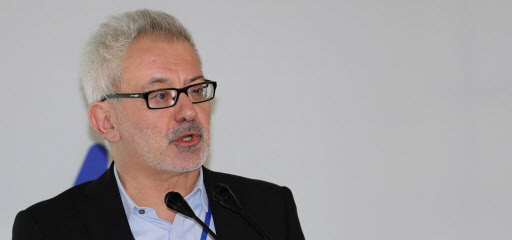South Korea's national museum of contemporary art will present a series of exhibitions featuring Andy Warhol, Pablo Picasso and other great artists starting next year, the museum’s director said Monday.
Bartomeu Mari, director of the National Museum of Modern and Contemporary Art, unveiled a list of exhibitions planned for next year and beyond under such themes as “Other Modernities,”
“Convergence of Architecture, Design, Cinema,” and “Modern and Contemporary Masters.”
“I think it is very important that the major museum in Korea offers opportunities to see the works of what you call the modern or contemporary masters,” the Spaniard said during a press conference held at the museum's Seoul branch. “No doubt Andy Warhol is one of those.”
“Andy Warhol: Shadows” will be displayed at the Seoul museum from February to June next year. It consists of 102 silkscreened canvas panels that show the same seven or eight screens in different lights and with arbitrary spots. According to Mari, the painting is considered to be “one of the most enigmatic” in the career of the American artist, who is best known for his work in pop art.
“Everybody knows the name (Warhol), but I’m sure Korean citizens have not had many occasions to see it directly if not traveling abroad,” he said.
In November, the museum will host an exhibition of some 80 works by the British pop artist Richard Hamilton. Produced in time for the 2017-2018 year of exchange between South Korea and Britain, it will be the first retrospective of Hamilton in Asia following his death in 2011. The artist is considered to have played a key role in shaping public perception after the war with images depicting the formation and workings of human expectations, consumption and desires.
The exhibition will be held through January 2018 at the museum's branch in Gwacheon, south of Seoul.
Meanwhile, in the summer of 2018, MMCA will present “Picasso and the Popular Arts and Traditions” to show how modern art has not only been inspired by rationalist and machine-made culture but also influenced by rural and traditional culture, including crafts.
“It’s a completely different way to look at modern art that also will help us develop other directions from our program and our modernity,” Mari said.
MMCA will keep a focus on Korean contemporary art, too, he added.
 |
Bartomeu Mari, director of the National Museum of Modern and Contemporary Art (MMCA), speaks during a press conference at MMCA, Seoul in Sogyeok-dong on Monday. (Yonhap) |
“One of my concerns is that before becoming global or trying to represent global context, it has to be Asian,” the director said.
“The art system is more and more aware that the Asian modernity and contemporary art is one of the strongest and more solid voices nowadays and we would like to reflect that link with our program in different ways.”
Under the theme “Korean art in Asia and the global context,” the museum will have exhibitions of crafts, sculptures, photos and architectural designs by living Korean artists.
“It's an obligation, it’s a tradition that the Korean contemporary artists series are showcasing Korean artists that compose in different areas of contemporary art,” Mari said. “This program means continuity with the history of this museum. It also means a serious attempt to bring contemporary art into history.”
Mari noted that South Korea‘s National Assembly approved a 45 percent on-year increase in MMCA’s budget for next year. With an increased budget of 72.4 billion won (US$61.7 million), it means the museum has to “deliver a very good, a very strong program to society,” Mari said.
To improve quality, the director said he has appointed two people to each handle public programs and publications.
In 2017, the public programs will include a symposium jointly organized with the Tate Research Center: Asia on Asian art after 1989, and a curatorial workshop with Tate on the future of national collections.
In promoting Korean art abroad, Mari stressed the importance of publication.
“The museum produces a large number of exhibition catalogs but they‘re not distributed internationally,” he said. “Catalogs properly published, edited, accessible in English at least because it’s the lingua franca, are a condition of the internationalization of Korean art.”
He added, however, “I’d like to insist that the international promotion of Korean art is not only a question of export. In my opinion, it is making Korea a platform of international art. We are progressing a lot. It is more and more clear that Korea and Seoul as the capital is already a big international metropolis and we have seen this year many, many international colleagues, curators, directors and collectors visiting our country and the different institutions it has to offer.”
On Tuesday, MMCA will sign an agreement with the National Museum of Contemporary Art in Spain under which the two sides will exchange their collections in 2018-2019.
The director, who took office last December for a three-year term, expressed an interest in becoming more involved in the Korean art community.
“I have tried to speak to many artists, curators, galleries, collectors, patrons,” he said. “I wish I would be able to do it more. There is a lot of people I still need to meet, I still need to get acquainted with. I am full of attention for what people have to say. It is basic for the job that I do to listen to the people around and their opinions.” (Yonhap)








![[Today’s K-pop] Blackpink’s Jennie, Lisa invited to Coachella as solo acts](http://res.heraldm.com/phpwas/restmb_idxmake.php?idx=644&simg=/content/image/2024/11/21/20241121050099_0.jpg)